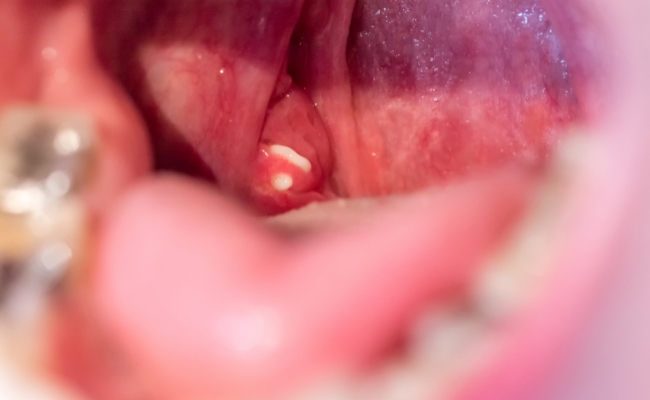How to Treat Salivary Gland Stones?
- January 31, 2024
- No Comments

What are Salivary Gland Stones?
Salivary gland stones, medically referred to as sialolithiasis, are calcified deposits that develop within the ducts of the salivary glands. These glands, pivotal for oral health, produce saliva, contributing to digestion, mouth moistening, and protection against tooth decay. The formation of these stones obstructs the glands, resulting in symptoms such as pain, swelling, and challenges in swallowing.
Why Do Salivary Gland Stones Occur?
Salivary gland stones develop when the chemicals in saliva crystallize and form hard deposits. The exact cause of this process is not always clear, but several factors can contribute to the formation of these stones. Dehydration, reduced saliva flow, and changes in the composition of saliva can create an environment conducive to stone formation. Additionally, certain medications, such as antihistamines and diuretics, can decrease saliva production, increasing the risk of stone development.
How Do Salivary Gland Stones Affect the Body?
When salivary gland stones obstruct the flow of saliva, it leads to swelling, pain, and discomfort. The symptoms may worsen during meals when saliva production is naturally stimulated. In severe cases, the blocked gland can become infected, resulting in a condition called sialadenitis. This can cause additional symptoms such as fever, redness, and pus drainage.
Treatment Solutions for Salivary Gland Stones
Managing salivary gland stones involves addressing the obstruction, alleviating symptoms, and preventing recurrent stone formation. Here are key treatment solutions:
Hydration and Saliva Stimulation:
- Adequate hydration is essential to promote saliva flow and prevent the stagnation of saliva that can lead to stone formation.
- Chewing sugar-free gum or sucking on sour candies can stimulate saliva production, assisting in the natural flushing of the ducts.
Warm Compresses:
- Applying warm compresses to the affected gland can help relax the duct and promote the movement of the stone.
- This simple home remedy can provide relief from pain and swelling associated with salivary gland stones.
Massage and Sour Foods:
- Gently massaging the affected gland may help dislodge smaller stones.
- Sour foods, such as lemon drops or vitamin C-rich fruits, can stimulate saliva flow and aid in stone expulsion.
Sialogogues:
- Medications known as sialogogues, such as pilocarpine, may be prescribed to stimulate saliva production and assist in stone passage.
- These medications are particularly useful for individuals with recurrent stone formation.
Duct Massage and Milk:
- A healthcare provider may perform a procedure known as duct massage to help push the stone out.
- Drinking plenty of water or milk during meals can facilitate stone movement and prevent future obstruction.
Surgical Intervention:
- In cases where conservative measures are ineffective, or for larger stones, surgical intervention may be necessary.
- Extracorporeal Shock Wave Lithotripsy (ESWL) uses shock waves to break up the stone, allowing for easier passage through the duct.
Salivary Gland Endoscopy:
- Sialendoscopy involves the insertion of a thin tube with a camera into the duct to visualize and remove the stone.
- This minimally invasive procedure is performed under local anesthesia.
Duct Dilation and Stone Removal:
- Duct dilation procedures, such as balloon dilation or stent placement, can help widen the duct and facilitate stone removal.
- This approach is considered for cases where stones are deeply lodged or recurrent.
Benefits of Treating Salivary Gland Stones
Effective management of salivary gland stones offers several benefits to individuals experiencing this condition:
Pain Relief:
Treatment helps alleviate pain and discomfort associated with swollen and obstructed salivary glands, improving the overall quality of life.
Prevention of Infections:
- By addressing the obstruction promptly, the risk of secondary infections (sialadenitis) is minimized.
- This prevents additional complications and the need for more extensive treatments.
Improved Swallowing and Saliva Flow:
Successful stone removal or passage enhances saliva flow, promoting better oral health and easing the process of swallowing.
Prevention of Recurrent Stones:
- Adopting preventive measures and lifestyle modifications can reduce the likelihood of recurrent stone formation.
- This includes staying well-hydrated, maintaining good oral hygiene, and avoiding factors that contribute to stone development.
Minimally Invasive Options:
The availability of minimally invasive procedures, such as sialendoscopy, offers effective treatment with reduced recovery times and minimal scarring.
Preservation of Salivary Gland Function:
Timely intervention helps preserve the function of the affected salivary gland, preventing long-term complications associated with chronic obstruction.
Patient-Specific Treatment Plans:
Healthcare providers can tailor treatment plans based on the size, location, and recurrence of salivary gland stones, ensuring individualized care.
Comments (0)